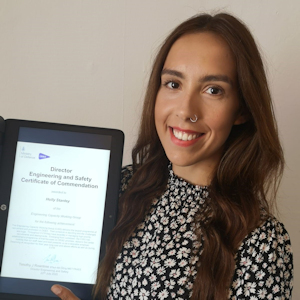We recently spoke with Talent Acquisition Manager Holly about her role in the HR function and her involvement in launching a new pilot scheme designed to remove barriers for neurodivergent job candidates.

Talent Acquisition Manager, Holly
Can you tell us about little bit about your role?
I’m a Talent Acquisition Manager within HR and my hiring area covers Engineering and Integrated Logistics. I currently have a team of four which is rapidly growing, and we ensure that the delivery of those organisation areas is filled with talented and diverse candidates. I also look after the Assessment and the Diversity and Inclusion work streams, where there is loads of amazing work being done by such an enthusiastic bunch of people, all working towards increasing diversity for DE&S.
What do you love most about what you do?
I love coming to work and working within recruitment, where you have such power to make a real difference. The best thing is collaborating with organisations to deliver great talent for DE&S, ensuring we cultivate an open and inclusive working environment, and that we get the opportunity to champion diversity and the benefits it will bring to our organisation.
What do you believe makes DE&S and inclusive place to be?
I think DE&S is making massive strides to become an inclusive and progressive place to work within the Diversity and Inclusion workstream. We are currently working on a wide range of initiatives including Diverse Assessors, where we use assessors from underrepresented groups from across DE&S to provide a more rounded voice at the selection table.
We’re currently working on developing a STEM Returners program, which will aim to support females back into work following career breaks, and we’ve been working on a Military Transition Scheme which removes barriers to entry for those leaving the armed forces. Transitioning into a civilian role can be challenging for service leavers, when you haven’t had a traditional ‘office job’ before.
We are also looking at anonymising CVs in our CV sifting process, to eliminate any unconscious bias. All of these initiatives are fully supported by senior stakeholders and the wider organisation, and the enthusiasm from everyone when we’re going through the lifecycle of these projects is unbelievable. It’s great to see that you have this level of backing, and to have everyone being equally as enthusiastic as our workstream is about it. It just spurs us on. I think it’s an incredibly inclusive place to be.
Can you tell us about the Autistic Hiring Programme? What is it and why is it important?
The Autistic Hiring Programme is there to remove barriers to entry for candidates who are neurodivergent into DE&S and the SDA. We’ve collaborated with the National Autistic Society (NAS) to transform the recruitment process to remove these barriers and support candidates with showcasing their strengths in an alternative way. We worked with NAS on various elements of the end-to-end process.
We changed our job advert to ensure that the criteria were even more specific to that individual role.
We created a video tour of our site in Abbey Wood, that was filmed from a candidates perspective and showed different areas of DE&S to make sure that it was an environment in which candidates with autism would like to work in, and so they would know what to expect. It showed sensory triggers like lighting and noise levels in the office alongside office size, break rooms, canteen spaces and toilets. So, it really did take them on a complete journey of what it’s like to work here.
We also designed a skills-based assessment. Our normal recruitment processes are a one-stage, face-to-face interview. However, we recognise that someone with autism may struggle with communication, so we created an on-the-job, skills-based assessment which assessed exactly what the role entailed. This evaluated if the candidates could do the tasks at hand and it was incredible to see candidates come to life during this section. Some candidates weren’t so confident in the face-to-face element, but in the skills-based assessment you really saw a difference. They were very happy to discuss how they did the assessment, what they liked about it, how they approached it and it was just amazing to see. If we had just done the face-to-face interview, we would have missed all these great skills and qualities that the candidates were able to show.
We also created a tool which talked the candidates through our long on-boarding process, and we presented a webinar about autism to the organisation, which ended up being oversubscribed. This really highlighted how invested the organisation is in this initiative. We’re also training managers on a bespoke training program tailored to these individuals, their specific type of autism and the reasonable adjustments the candidates might need. This ensures that the organisation is managing those candidates appropriately.
Standardised recruitment processes can act as a barrier to some neurodivergent candidates, so removing these barriers will provide them with the support they need, and will provide us with an untapped talent pool, whilst increasing diversity and achieving our ultimate aim of filling roles that we are unable to currently find the skills for.
So the plan is to continue on from our successful pilot and roll it out as standard for particular roles in certain specialisms such as engineering and IT.
What was your involvement in the pilot scheme?
I led on the project, working with other members of the workstream who did a huge amount of work liaising with the National Autistic Society. It was a real team effort. I worked with the Engineering function to design and implement the scheme, ensuring it was fit for purpose and that it was going to have the desired result.
How did you test the scheme?
We have a Neuroinclusivity network who were very important to the whole process and we also worked in collaboration with NAS. Everything we did, we made sure they vetted and approved it. NAS work with a lot of organisations so we were able to speak to them to check that we were in line with what other organisations are doing and actually in a lot of cases they said we were much braver than other organisations with removing different parts of the standard interview process. With the skills-based assessment, we user-tested it on neurodivergent engineering colleagues within the network.
How did it make you feel being involved in such a forward-thinking program?
I’ve loved it. It’s been such an enjoyable initiative to do and it’s really meant a lot to be able to work on this programme. Just over a year ago, I was discussing this topic and my own experiences with a colleague in the Engineering function, whose son has autism. He highlighted that this would be a great way to find candidates that we are struggling to find in the market, and it was from this conversation that we started to work together on the initiative. Working with someone who has such a personal connection to this and seeing the enthusiasm throughout the organisation grow as it all came together was really exciting. Being able to break these recruitment barriers really did mean a lot and made it feel like we were doing something really different, which was very rewarding.
How does it make you feel being part of an organisation that is being proactive supporting inclusivity?
It makes me feel really proud to be part of an organisation that promotes inclusivity as highly as DE&S does. Especially within the Talent Acquisition team, I think we are all so passionate about it and you can see the enthusiasm oozing from people when they start to talk about the differences that we’re making within the team. It means a lot when you have the potential to provide opportunities to individuals that may struggle to gain employment elsewhere. It means that we are contributing to attracting diverse talent, who feel supported here. It all feels very rewarding and since I started working here the organisation has made massive improvements to be inclusive and this journey that it’s been on has been really amazing to watch.
How would you describe the culture at DE&S?
I’ve been at DE&S for three years and the key thing I would say about the culture here is that we offer an ‘open door policy’ at all levels. That culture helps to promote new ideas and new ways of working and leaves us all open to bettering ourselves. Here I can easily go to my managers, or even my manager’s manager and have a conversation about something, because everyone wants to discuss and share knowledge. I think everyone is very friendly and really willing to support one another as well.
There’s a lot of great benefits to working here and we’re much better now at communicating it. We’re incredibly supportive of staff with responsibilities outside of work, for example parents with young children. We offer flexible working – and I mean genuinely flexible working. Whether you have caring responsibilities, you need to pick up your kids from school, or you just want to go to the gym every lunchtime, it really does support a great work-life balance that suits your unique way of living.
DE&S provides really good opportunities for women in leadership roles and there are a lot of initiatives to promote diversity, which I think is so important. The organisation is also becoming more inclusive, everyone has an aim of what they want to achieve from their working life, and they will get the support for that here. DE&S will invest in their people, whether that’s through on-the-job training or funded courses and qualifications.
Why is it important for us to have like lots of different like people from lots of different backgrounds?
A diverse workforce that is representative of its community breeds diversity of thought, and all of this helps to cultivate new ideas. If you have the same type of people in a room then you’re going to have the same ideas, whereas having diversity in the room across all levels, whether that’s leadership or mid-management or entry level, will benefit a wide variety of backgrounds, beliefs, and understandings which will create more innovative solutions than ever before. It’s important that we embrace it because it leads to best practice and innovation. With rapidly developing technology in an ever-changing environment, innovation is very important and ultimately helps DE&S fulfil our purpose, to protect and provide for the armed forces and keep people safe.
What feedback mechanisms are in place that enables people to have their opinions heard across the organisation?
There are lots of avenues for people to give their feedback. To go alongside an open and honest culture, whether that’s within networks or teams, we also have regular anonymous surveys that give everyone the opportunity to give their opinion. Within our team, our senior leadership team will go through the feedback from the surveys and will highlight the actions that are being taken as a result. This really makes you feel that your voice has been heard.
How does your team recognise colleagues’ achievements?
Yes definitely. In terms of recognition, within HR, we have an Employee of the Month system where colleagues can nominate each other to recognise their hard work and efforts and these get read out in our monthly HR meetings. Within our Talent Acquisition team we have a “Positivitree”. In the office this used to be a physical wooden tree when people could write leaves on, and the leaves would contain feedback, a thank you or recognition of a colleague’s work. Since working from home became more prominent, we now do this virtually and these get read out every Monday morning during our team call, which is a really nice, positive way to start the week.
Latest HR vacancies
Can’t find an HR job for you today? Search all our vacancies.


